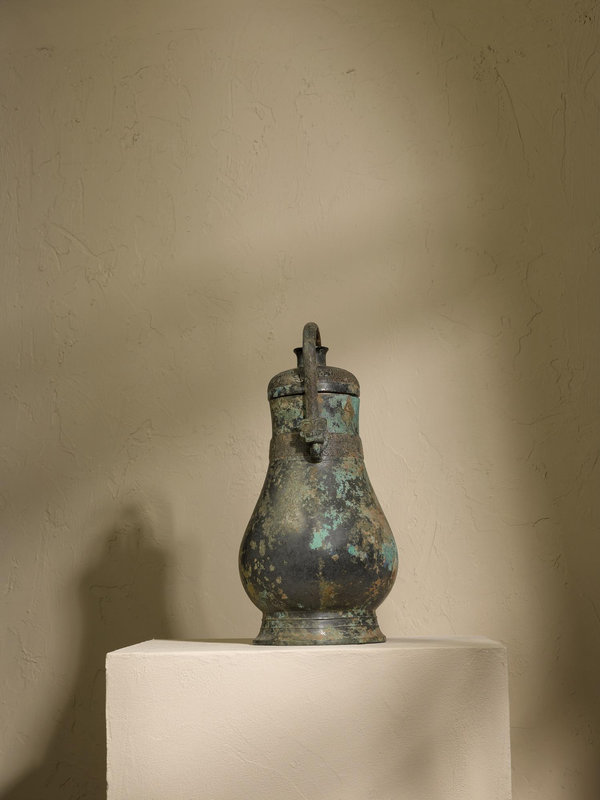A rare large inscribed archaic bronze ritual wine vessel and cover, Hu, Early Western Zhou dynasty
Lot 201. A rare large inscribed archaic bronze ritual wine vessel and cover, Hu, Early Western Zhou dynasty. Overall height 35.5 cm, 14 in. Lot sold: £176,400 (Estimate: £100,000 - £200,000). © 2022 Sotheby's.
cast to the interiors of the cover and vessel with a six-character inscription reading Qi Zuo Fu Yi Zun Yi (Qi made this precious vessel for Father Yi); together with Yu Xingwu, Shuangjianyi guqiwu tulu [Catalogue of ancient objects from the Shuangjianyi], vols 1-2, Beijing, 1940.
Property from a distinguished European Private Collection.
Note: Finely cast with a well-proportioned pear-shaped body and narrow horizontal decorative bands depicting taotie with bulging eyes, this well-published bronze vessel is an outstanding example of the early Western Zhou period. Wine vessels such as the present emerged as one of the major ceremonial receptacles at ancestral rituals in the late Shang dynasty and remained prominent until the mid-Western Zhou dynasty.
Fig. 1 Yu Xingwu, Shuangjianyi guqiwu tuli [Catalogue of ancient objects from the Shuangjianyi], vol.1, Beijing, 1940, pl. 19.
Compare a similar bronze wine vessel and cover, with a three character inscription reading Chai Fu Yi, excavated in 1962 from Feng Jiabo, Yi Cheng county, preserved in the Shanxi Provincial museum, Taiyuan, illustrated in Shanxi Wenwu Guancang zhenpin/Selected Cultural Relics From Local Museums in Shanxi, Taiyuan, 1996, pl. 52; and another flanked by a pair of prominent rhinoceros heads and cast to the interior of the vessel with a fourty-two character inscription, discovered in Anyang, Henan province and now preserved in the Palace Museum, Beijing, illustrated in Gugong Qingtongqi/Bronzes in the Palace Museum, Beijing, 1999, pl. 65.

/https%3A%2F%2Fprofilepics.canalblog.com%2Fprofilepics%2F1%2F0%2F100183.jpg)
/https%3A%2F%2Fstorage.canalblog.com%2F03%2F02%2F119589%2F96711876_o.jpg)
/https%3A%2F%2Fstorage.canalblog.com%2F11%2F31%2F119589%2F94773502_o.jpg)
/https%3A%2F%2Fstorage.canalblog.com%2F20%2F83%2F119589%2F94772815_o.jpg)
/https%3A%2F%2Fstorage.canalblog.com%2F26%2F72%2F119589%2F75604929_o.jpg)
/https%3A%2F%2Fstorage.canalblog.com%2F59%2F60%2F119589%2F26458628_o.jpg)







/image%2F1371349%2F20240425%2Fob_e64568_440367995-1657703268333019-41468471616.jpg)
/http%3A%2F%2Fstorage.canalblog.com%2F63%2F62%2F119589%2F129821675_o.jpg)
/http%3A%2F%2Fstorage.canalblog.com%2F43%2F82%2F119589%2F129801198_o.png)
/http%3A%2F%2Fstorage.canalblog.com%2F40%2F90%2F119589%2F129784381_o.jpg)